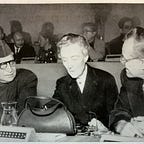The ‘Other’ Bandung
Historians everywhere view the 1955 Asia-Africa Conference as the starting point for Afro-Asianism. The conference has become such a byword for Afro-Asian solidarity that the simple invocation of ‘Bandung’, the city in which it was held, conjures up familiar images of the leaders of newly decolonized nations standing shoulder to shoulder in their conviction that colonialism is an evil which should speedily be brought to an end. In reality, however, the resolution on colonialism in the final communiqué had been a hard-won battle. Debates on whether it should explicitly include new forms of imperialism had almost brought the conference to a standstill. But so successful was the performance of unity that it sparked a new conceptual approach: the study of diplomacy as theater. The conference, like any performance, had a meticulously designed front stage but looked very different from the wings. G.H. Jansen, an Indian diplomat-turned-journalist and keen observer of all things Afro-Asia, found it simpler to speak of two Bandungs:
Two conferences were held at Bandung in April 1955. One was the real conference, about which not very much is known, about which people care even less, and which has faded away like a bad dream. The other was a quite different conference, a crystallization of what people wanted to believe had happened…
But to all intents and purposes there were indeed two Bandungs, and not just in a metaphorical sense. Two large international conferences were convened in Asia in April 1955 to discuss problems of common interest, Afro-Asian cooperation, and the mounting tensions of the Cold War. From the 18th to the 24th, Indonesia played host to its famous and carefully staged display of Afro-Asian diplomacy. Scarcely more than a week earlier, between the 6th and the 10th, New Delhi had been the site of another conference with similar aims.
The Delhi conference has largely been forgotten, so why put the two in dialogue with each other? At first sight, the contrast between the two conferences could not have been greater. Bandung was closed to the general public, and even photo-ops outside the conference venue were carefully orchestrated. In Delhi, by contrast, the general public was the conference. The conference was held outdoors, and estimates by the attending press ranged from 10,000 to 20,000 attendees. Alongside political leaders who used the conference as a stopover on the way to Bandung, the conference convened artists, poets, journalists, and dissidents. It also convened hundreds of activists from local peace councils who were drawn by the conference’s agenda for nuclear disarmament.
Against the backdrop of the Cold War, the Delhi conference was a perfect storm of grass-roots activism, dissenting voices, emerging third worldism, and the presence of a Soviet delegation. By its second day, the New York Times already spoke of a communist-tinged Asian peace conference. By the end of the conference, this had changed to ‘Reds Urge World to Give Up Arms’. However, that assessment belies the fact that several of the Bandung delegates, including those from Egypt, China, and Afghanistan, took part in the Delhi conference in an unofficial capacity. Both the conference’s size and the diversity of its participants made it an excellent barometer for public opinion and with it, for the political potential of Afro-Asian solidarity. It is therefore likely that popular sentiments expressed in Delhi traveled onwards to Bandung as well.
There is, however, another reason. The organizers and speakers in Delhi represented themselves as the popular equivalent of Bandung, and as a manifestation of the same Zeitgeist that had given rise to that conference. Conversations between political leaders were invariably reported as ‘eve-of-Bandung meetings’ and the Delhi conference self-consciously wished the Bandung conference success in its final resolutions. In the Indian press at least, the conference was framed as a successful manifestation of international solidarity that foreshadowed similar outcomes at Bandung.
In many ways, the Delhi gathering was the conference that ‘people wanted to believe had happened’, as per Jansen’s sardonic note. As an unofficial gathering unencumbered by the constraints of international diplomacy, the fabled Bandung Spirit must perhaps be located here rather than in Bandung itself. The Afro-Asian solidarity expressed in Delhi gave rise not to a withering voting bloc in the United Nations, but to a set of lively additional Afro-Asian political gatherings as well as literary and artistic ones. It was also instrumental in the formation of the Afro-Asian People’s Solidarity Organization (AAPSO).
The AAPSO’s first big gathering was organized in Cairo, and the explicit support from Nasser is more likely to have originated in Delhi than in Bandung. Nasser marketed the Cairo Conference as a ‘People’s Bandung’ from the very start, quoting the Delhi conference more than anything else. Afro-Asian solidarity turned out to be more viable in the popular realm than in international politics, which makes it especially poignant that the fourth Afro-Asian People’s Solidarity Council came full circle and was convened in April 1961… in Bandung.
